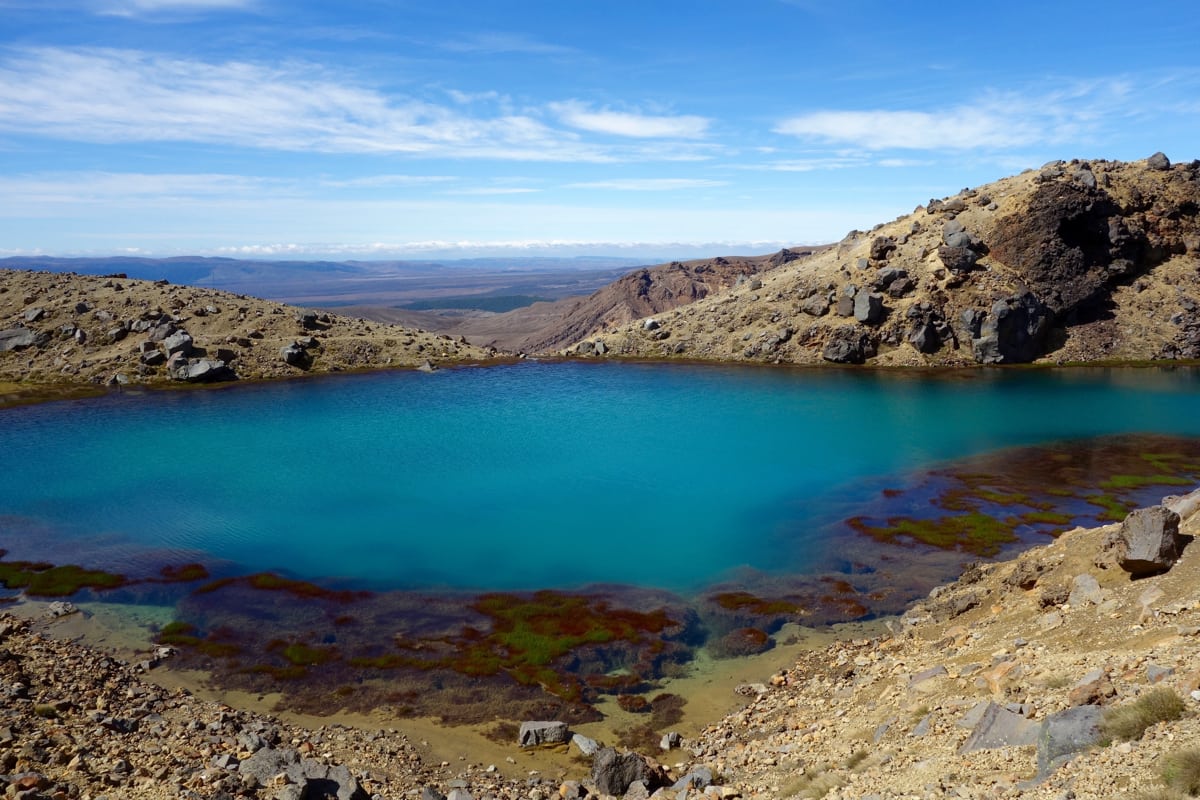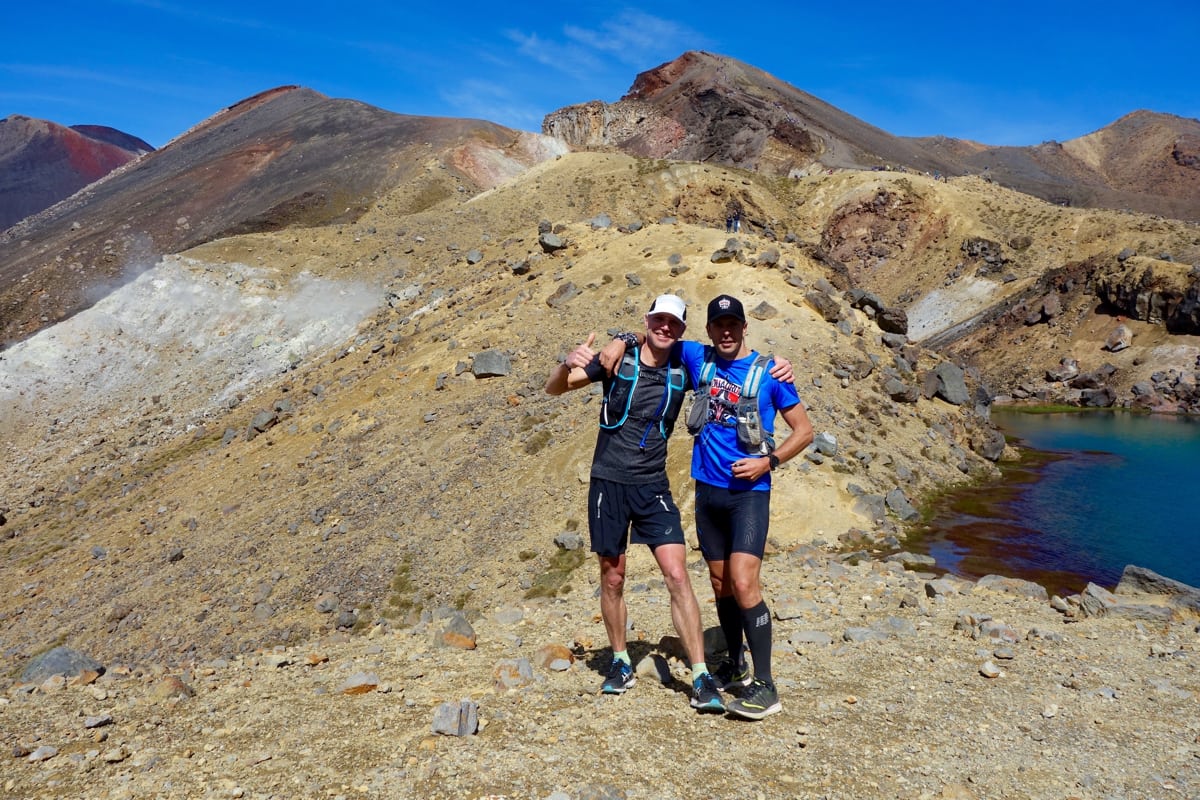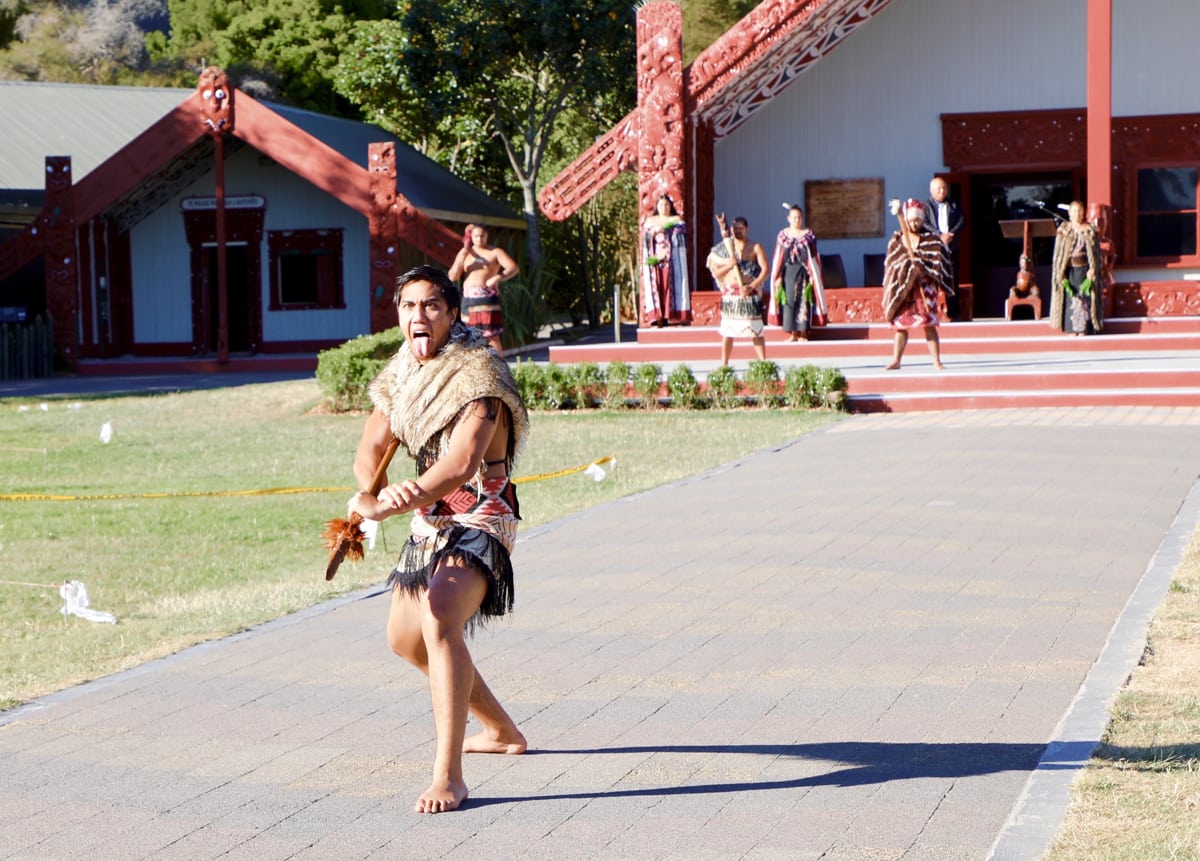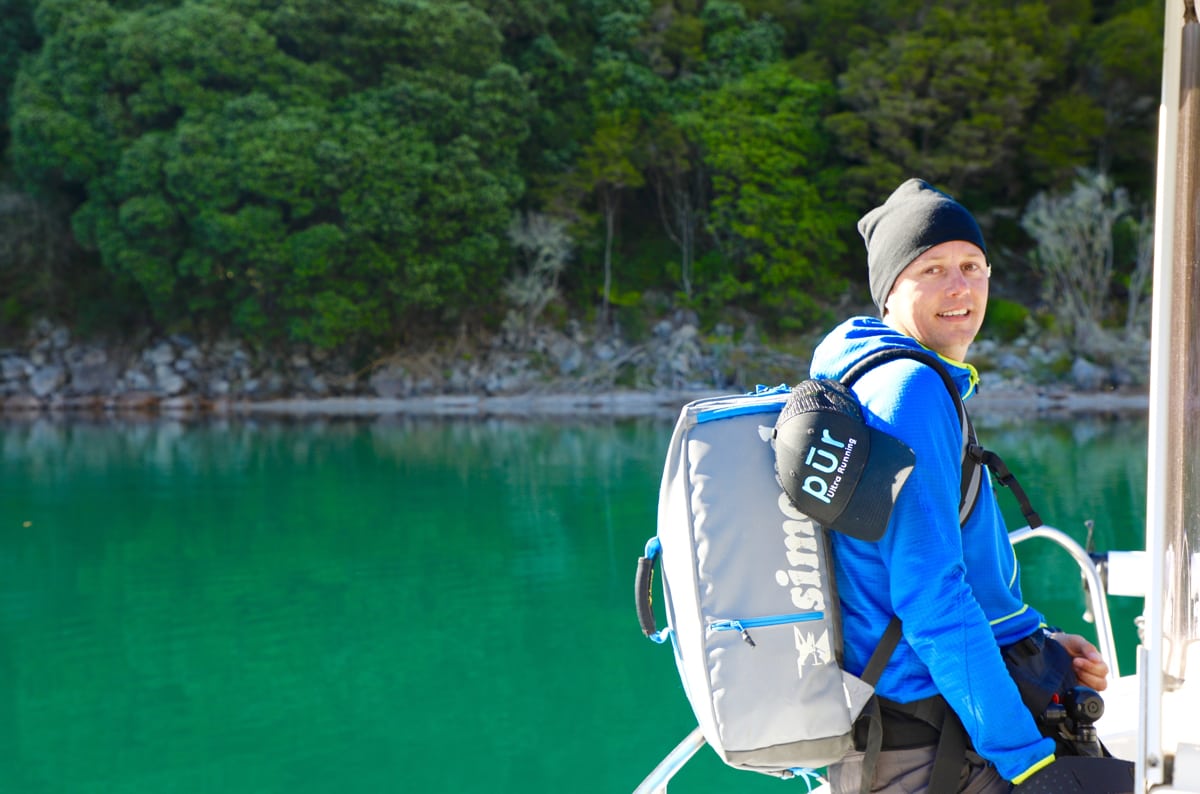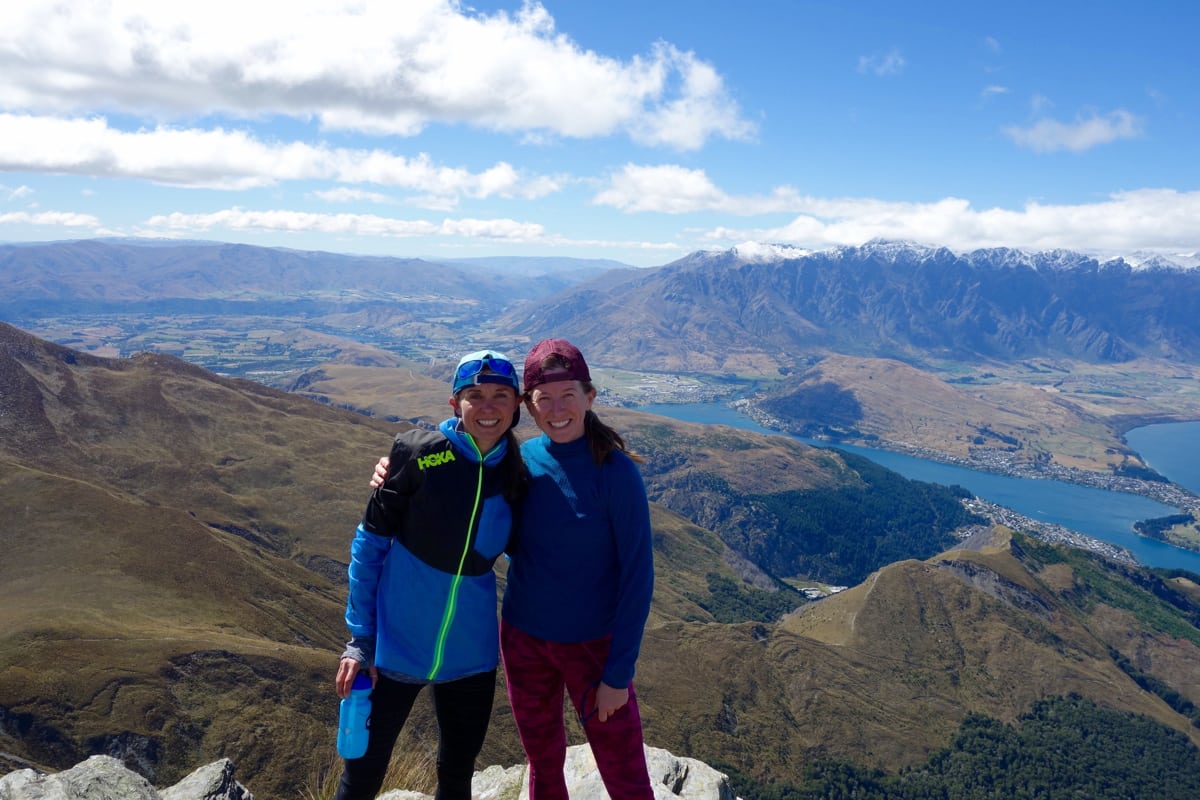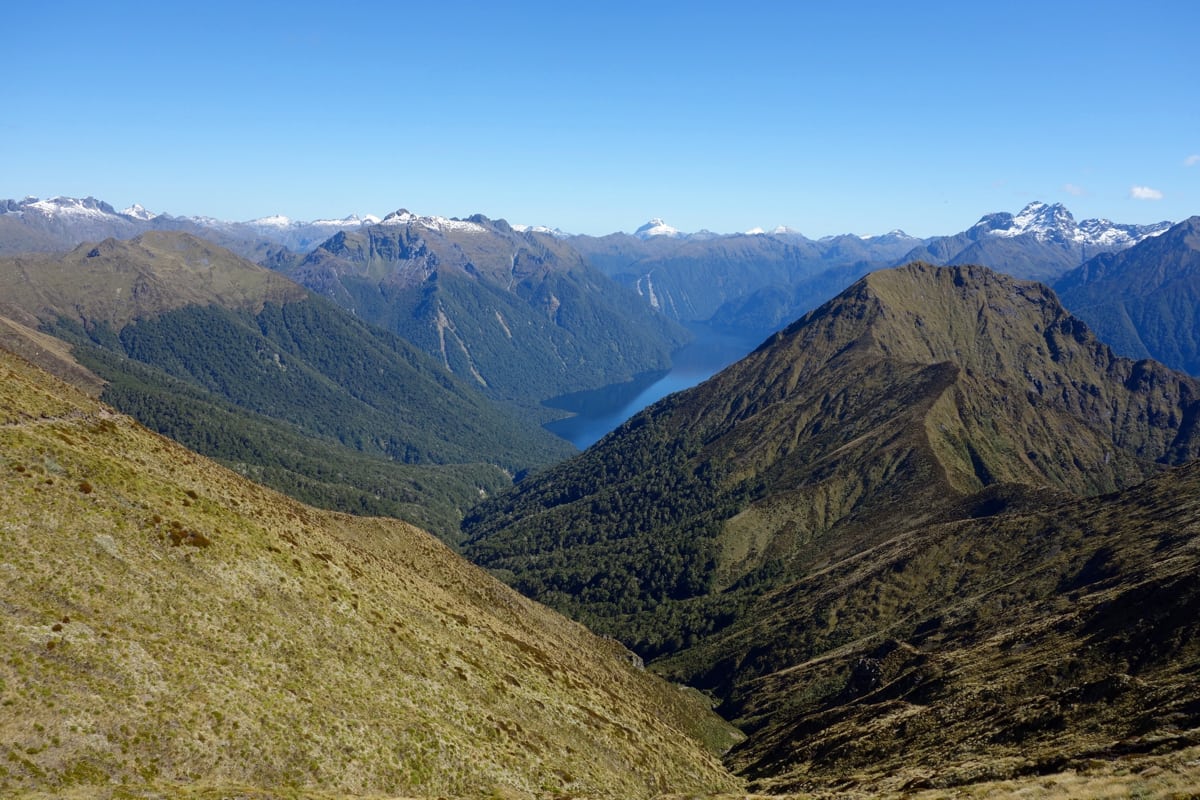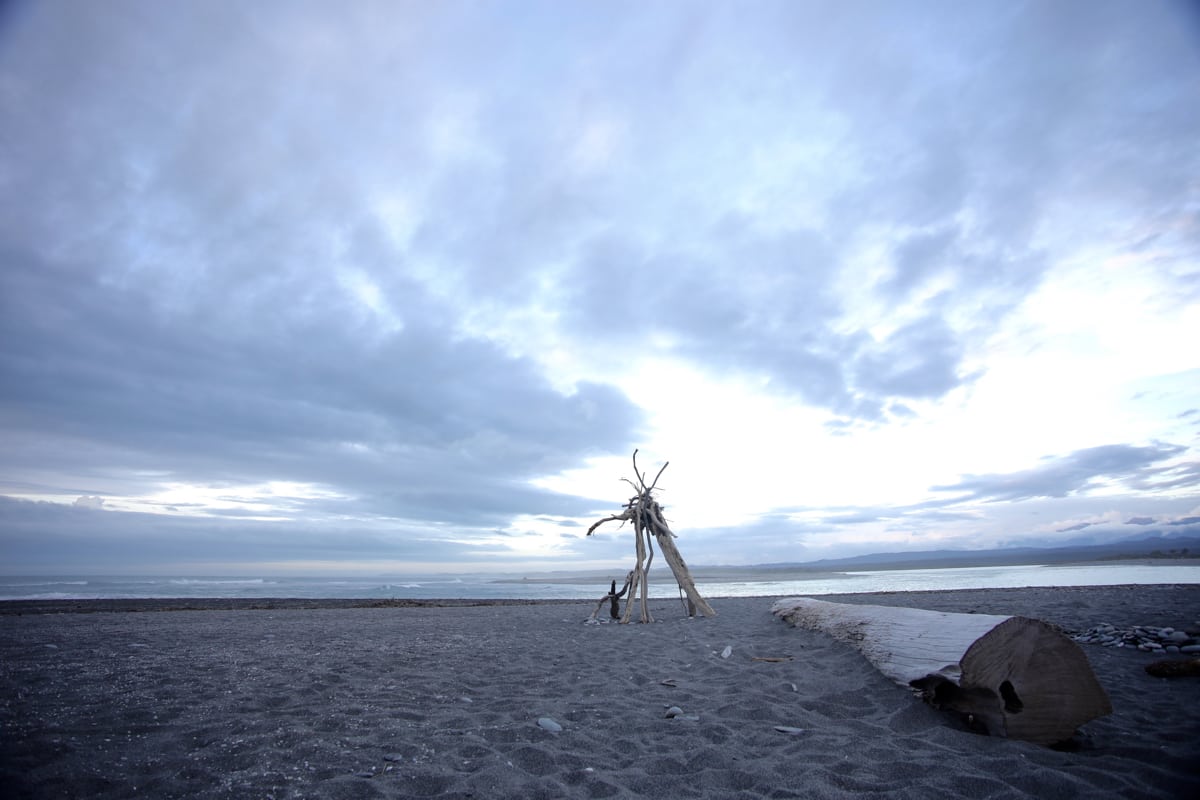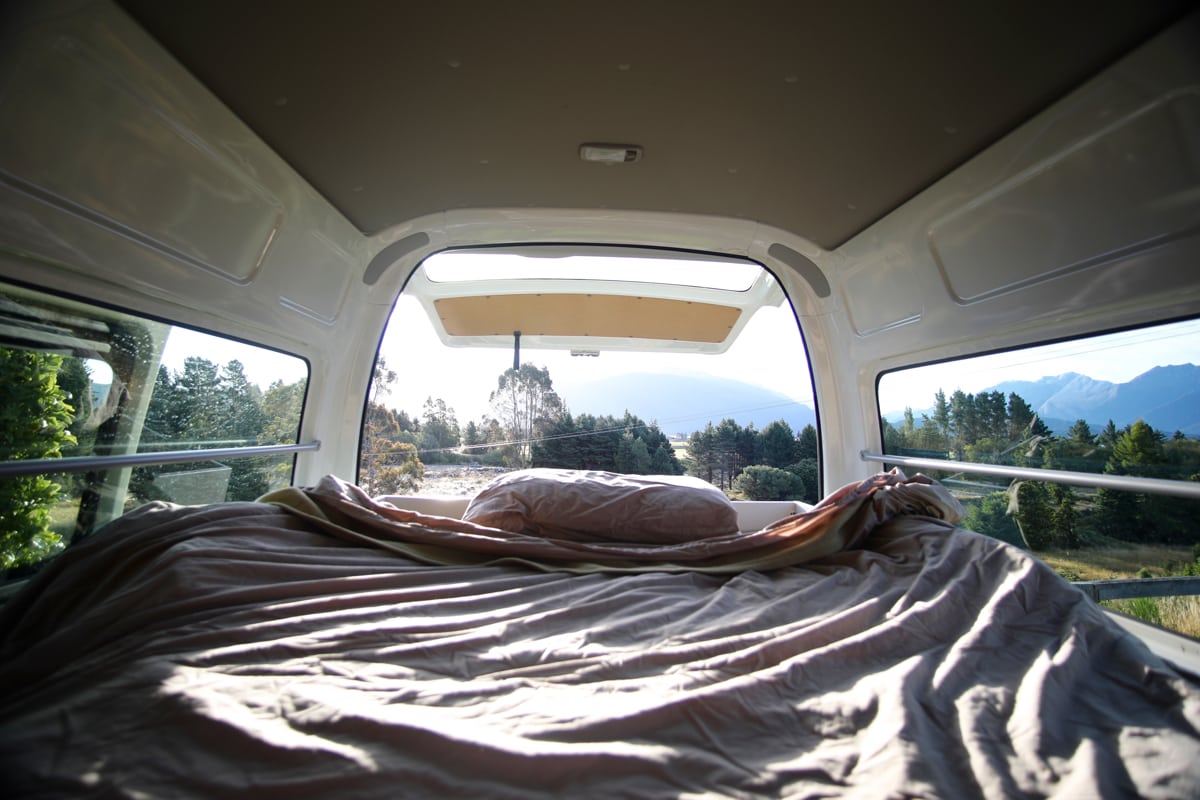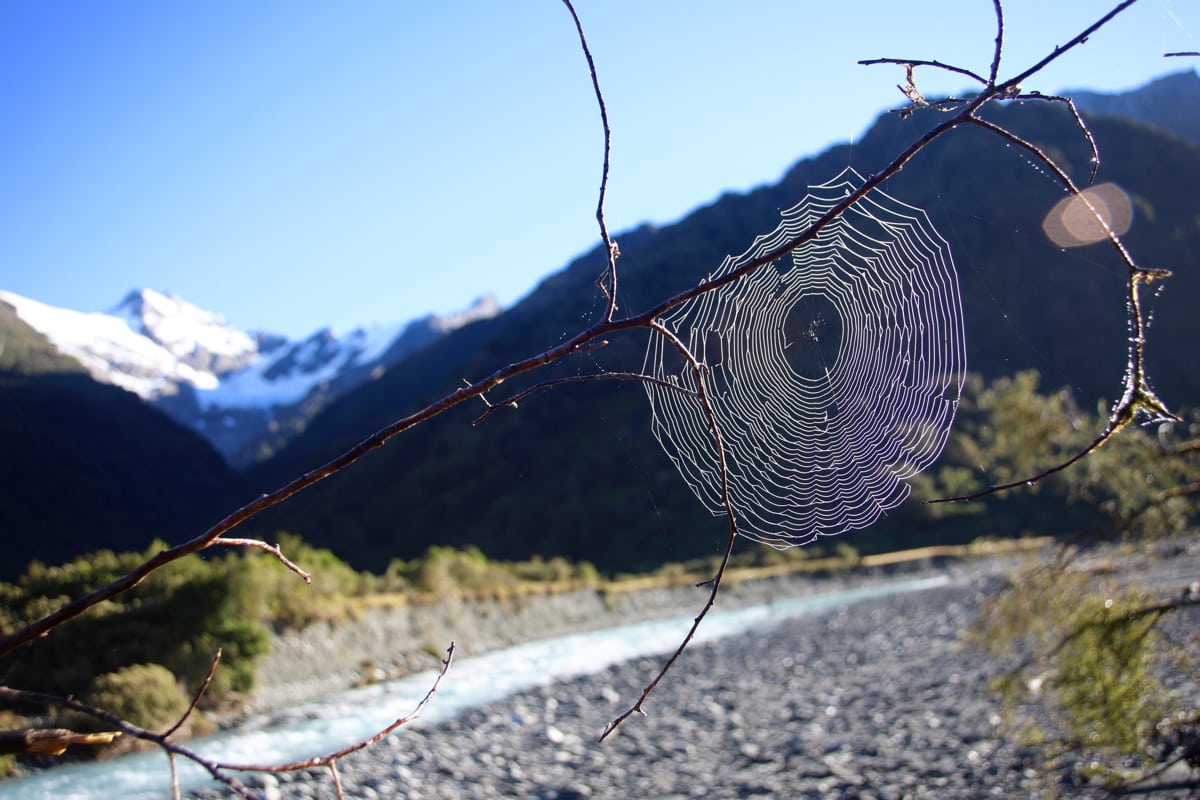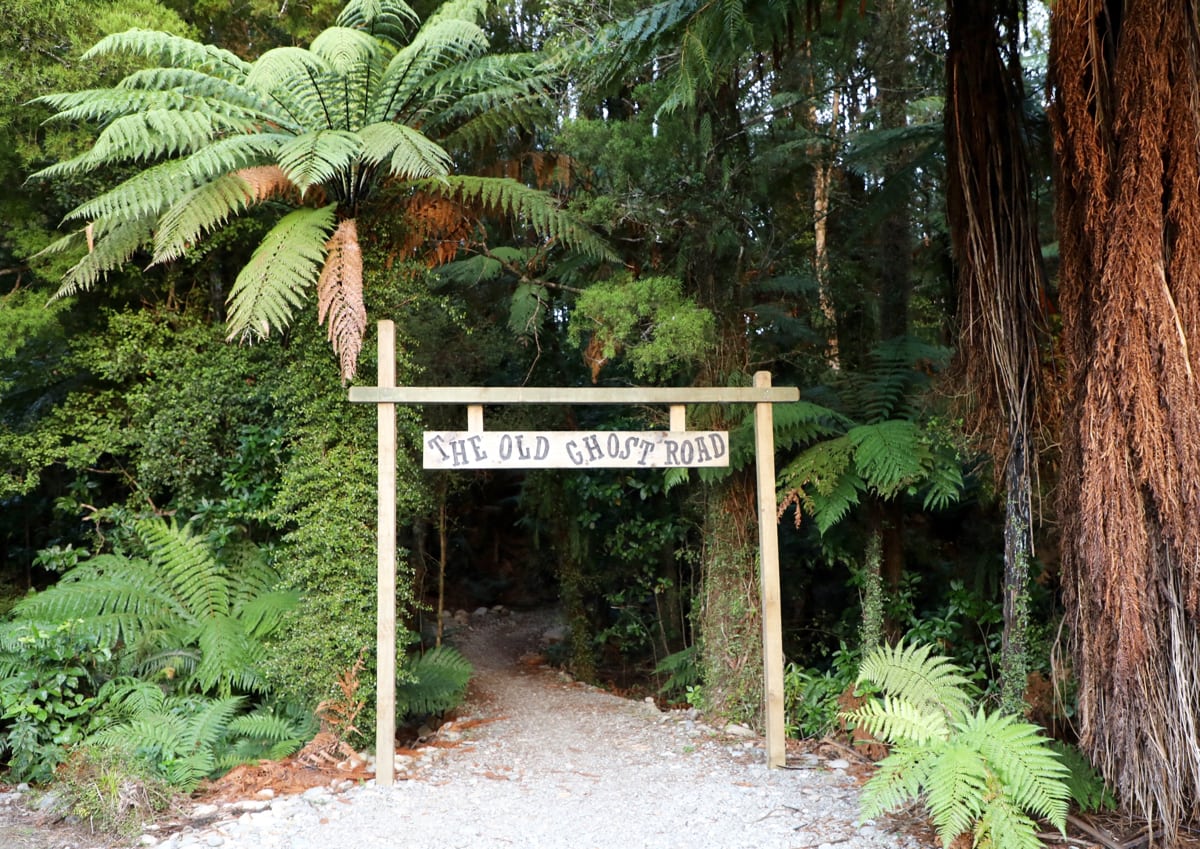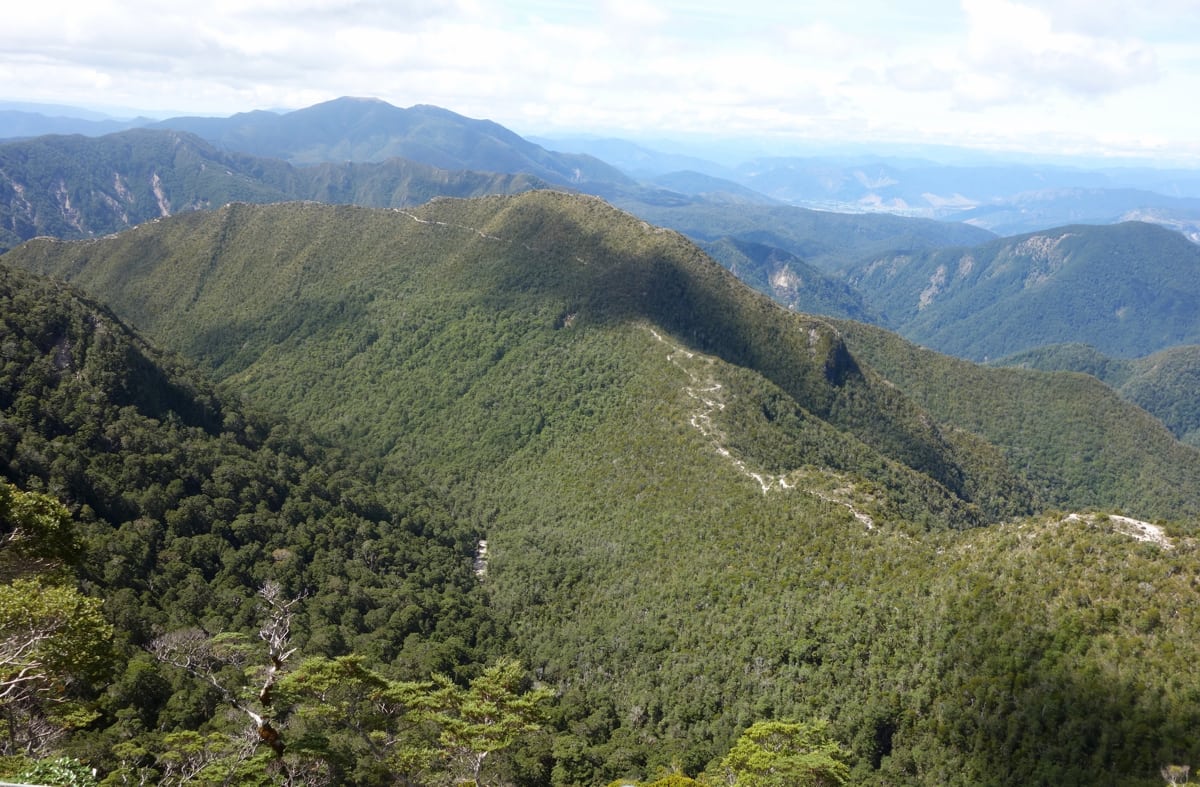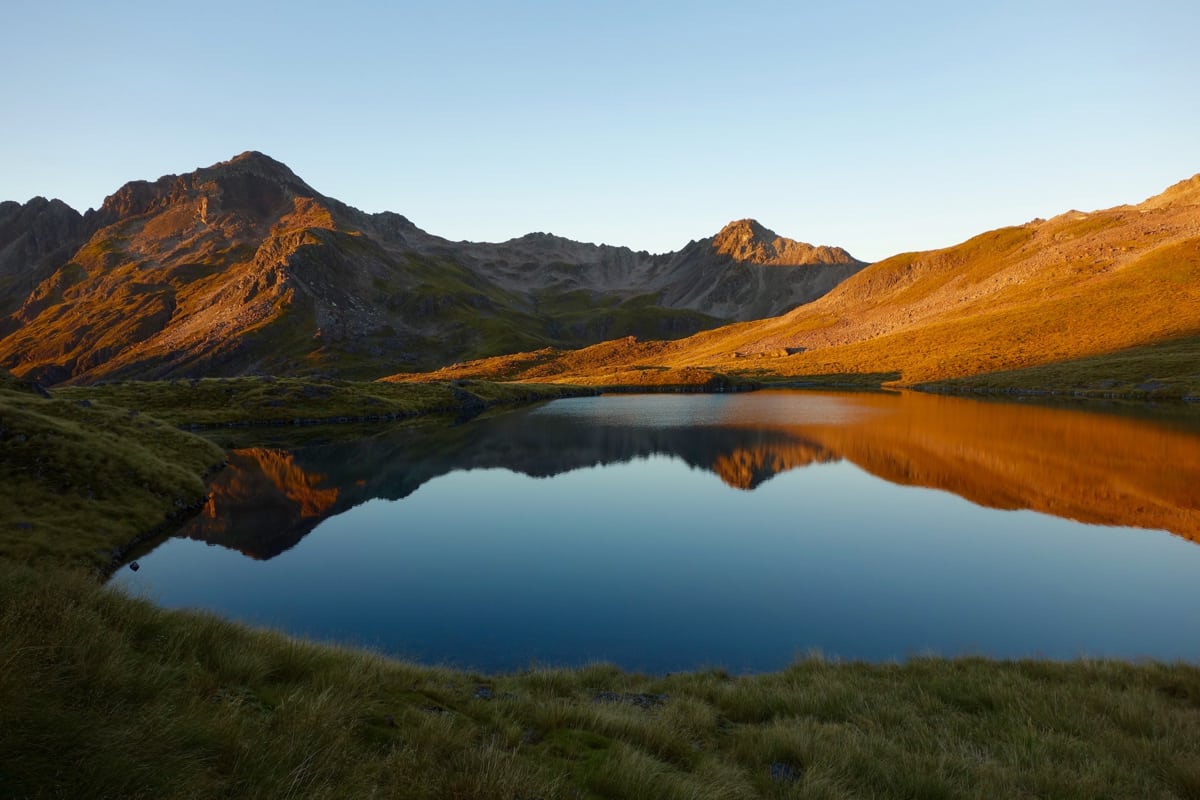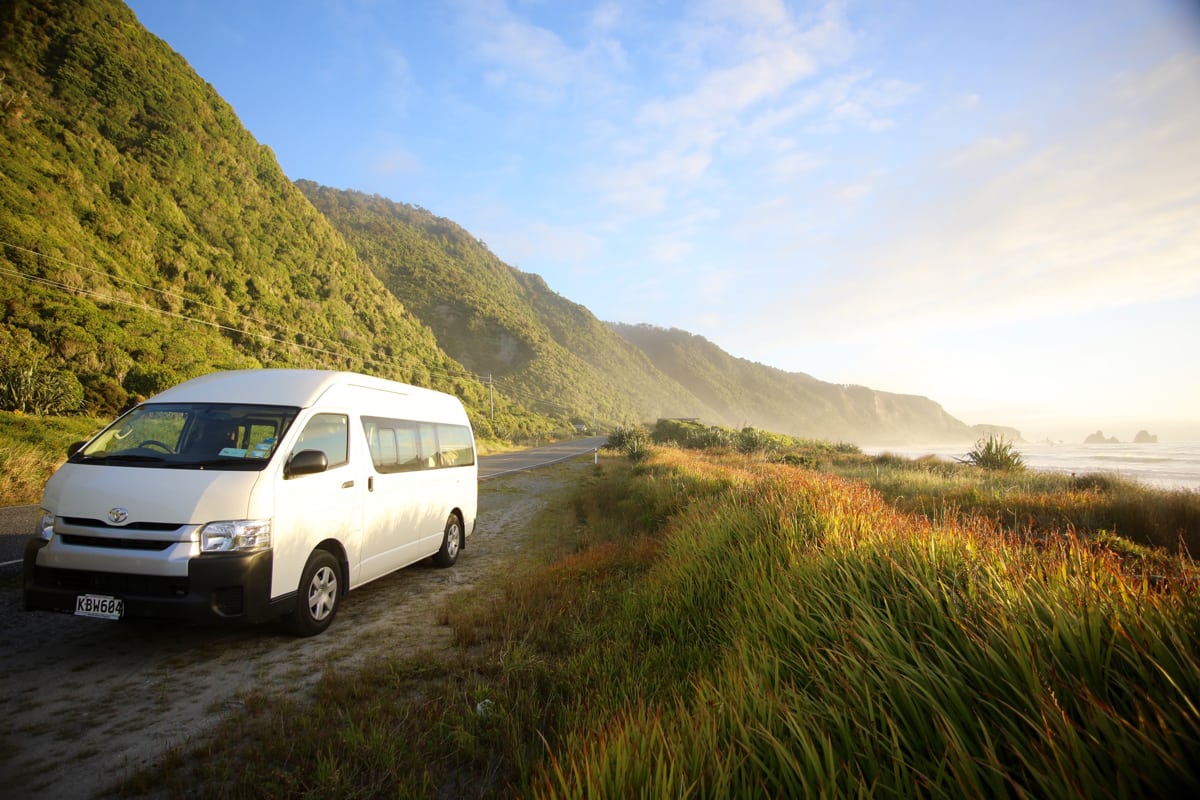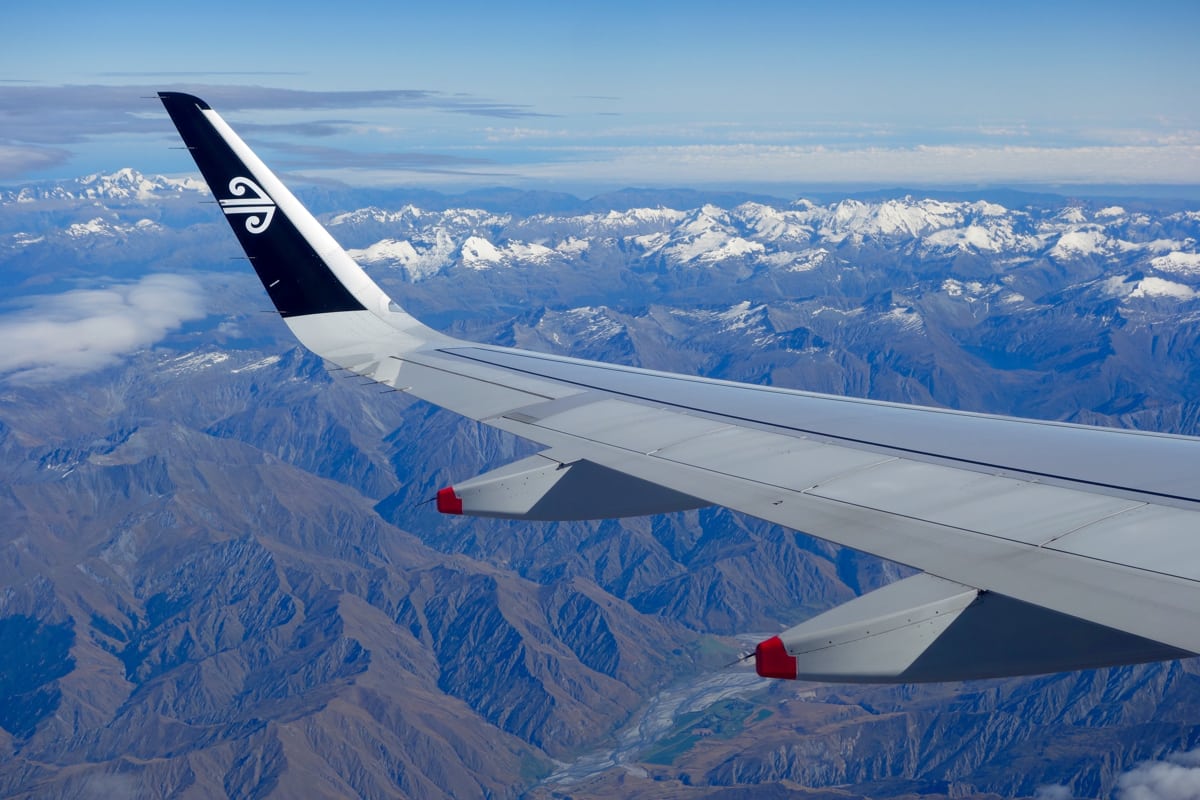[Author’s Note: In February 2017, iRunFar Senior Editor Meghan Hicks traveled in New Zealand for a month. This article is a collage of her experiences.]
Wednesday, February 1, 11 p.m., San Francisco, USA
I am sitting in a window seat with five more inches of legroom than I’d anticipated. It’s somewhat confounding that such a thing is celebrated in the airline industry, but when this chair is about to be my home hurtling through time and space and across the equator and Pacific Ocean for the next 13 hours, I do feel grateful to United Airlines for the surprise upgrade into their ‘Economy Plus’ section of the airplane. As I’m pattering away on last-minute emails and passengers continue boarding, my phone lights up with a message from my friend Kerry Suter. I will shortly be staying at his house in Rotorua, New Zealand for a couple days of play before I work at the Tarawera Ultramarathon next week.
The message contains a link to a 27.5-mile loop through Tongariro National Park, located south of Rotorua a couple hours and in the North Island’s famous volcanic highlands. I recognize the link from my recent online bantering with Kerry. In the previous weeks, he’s sold me on running this route, the Tongariro Northern Circuit, one of New Zealand’s famous Great Walks. He casually adds a second message, “That’s happening with Meghann [sic] and Jonas and I. Saturday 8:30am.”
My stomach lurches. What he’s really saying is that 18 hours after I finish this ridiculously long journey from my home in Moab, Utah, to his, he’s scheduled me to run a lot of miles with he and previous IAU 100k World Champion, the Tarawera Ultramarathon defending champ, and serious running stud muffin Jonas Buud.
This is going to leave a mark.
Friday, February 3, 10 a.m., Auckland Airport, New Zealand
I’m bleary eyed from that transoceanic flight, but it’s mid-morning on a Friday and the Auckland Airport bustles. I have a couple-hour layover before my fourth and final flight into Rotorua. I’ve completed my requisite arrival-to-New-Zealand legal duties–like showing the customs officers that my running shoes are dirt-free–and have moved on to my requisite personal duties of acquiring a large cup of coffee and a Wi-Fi connection to hammer away on work. My years of traveling have taught me about these mornings of long-haul travel: tired or not, jump into the current and swim hard.
I notice right away, though, that the water flows in the Auckland Airport at a slower pace than many of the airports I visit. People walk slowly, chat to strangers, and, surprisingly, some are barefoot. I wait at a coffee stand next to a man wearing a blue button-down dress shirt–untucked–a pair of knee-length khaki shorts, and no shoes.
“No shoes is normal New Zealand attire,” I observe to him when we make eye contact.
“Totally normal,” he smiles back. “Where are you from?”
“Obviously not here,” I say, laughing.
He says, “You’re from America. No shirt, no shoes, no service. I know how it is.”
“Called it,” I laugh, hard now.
“A lot of things are different in New Zealand,” he says. “I hope you like it here.”
“I already do.”
Saturday, February 4, 1 p.m., Tongariro National Park
Jonas, Kerry, and I have been running for almost five hours on the Tongariro Northern Circuit. Well, mostly, we’ve been playing this trail like an accordion. We run in a train for some small unit of time, and then Jonas and Kerry gap me, and then Jonas gaps Kerry, and then Jonas stops to let us both catch up. If you’ve ever been in the back of one of these accordion-style runs, then you know that, for the last person, it’s basically a tempo workout with no recovery. You run like heck to catch up to the group, and as soon as you do the fast one at the front takes off. It is brutal but logical: they are fully rested from waiting for you to arrive.
In addition to the pace, I am also battling climate. It’s summer and somewhat humid here, and I’m from winter in the low-humidity desert. Of course, Jonas is from Sweden where it’s currently much colder than my home and I don’t know that he’s even broken a sweat today.

Mount Ngāuruhoe and its volcanic environs as viewed from the Tongariro Northern Circuit. All photos: iRunFar/Meghan Hicks
Kerry’s got some app on his phone that talks out loud, reporting our pace and Kerry’s current heart rate. The kindly female voice consistently tells us that Kerry’s heart rate is in the 140s and 150s beats per minute, which is probably right around normal long-run pace for a guy like him. He’s also nonstop talking–this is his style–which means he passes the talk test just fine, too.
I am alone in my suffering.
To be fair, I don’t mind the body hurt too much–it’s par for the course in trail and ultrarunning. You don’t sign up for this shit because it’s painless. You sign up for it because, in this case, you explore all day an active volcanic wonderland, weaving amongst recent a’a lava flows, steam vents, and clear hot-spring ponds. You gallop down steep cinder hills which offer the sort of physical levity you imagine you’d feel on the moon as a result of its reduced acceleration due to gravity. You watch a world-class athlete dance across the terrain like he was made to do precisely what he is doing.
At the top of a hill some six miles from the finish, I apologize for about the 93rd time for holding up the dude train. Jonas says, “We are just the same.” I’ve known Jonas for about a half decade now and I know him to be incredibly kind, but also indelibly brief with his words. Thus, I interpret this to mean something like, “Hey Meghan, it’s alright. We’re here to have a good time and enjoy this magnificent scenery. It doesn’t matter that I could run this loop twice in the time it’s taking for us to run it once. That’s no big deal.”
A little while later, when it’s all said and done and we are comparing biometric notes from our data-gathering devices, Jonas says that his average heart rate for the day was 114. We all laugh and I think to myself, my legs feeling the dull ache of today’s work, No, Jonas, we are not actually the same.
Friday, February 10, 9 a.m., Rotorua
The Tarawera Ultramarathon festivities are officially beginning. The race will start tomorrow morning before dawn. This morning, race participants are at Te Puia, a Māori cultural center and place containing a collection of geothermal features including the Pōhutu geyser–which looks and acts a lot like the famous Old Faithful geyser on my home continent. The Māori are New Zealand’s original inhabitants, and Tarawera Ultramarathon’s welcome ceremony, taking place right now, is a blessing from the Māori to the race and its participants.
As this is my first trip to New Zealand, it is also my first time watching a pōwhiri, a traditional Māori ceremony. The performers are wardrobed in white, red, and black garments which include ornate stitchwork, beadwork, and bird feathers. Both women and men perform the ceremony. The pōwhiri involves chanting, various physical movements, and facial expressions. In the ceremony’s crescendo, a tribal representative comes face to face with a representative of the Tarawera Ultramarathon, in this case men’s defending champion, Jonas. After a minute or so, Jonas and the performers back away from each other and the performance concludes.
I don’t understand what was chanted in Māori during the pōwhiri, but I can tell you how it makes me feel. A wave of nervousness washes over me in watching two men come so close together, in eye contact with each other. It takes a little while to realize why I might feel this. We live in the day and age of secondary, passive, and often electronic communication means. A pōwhiri is an expressive, interactive form of communication–pretty much the polar opposite of what has become our norm. I also feel the ceremony’s intensity as it emanates among the couple hundred race participants who are standing in a wide arc and who fall silent in observance.
From this morning moment, my day cranks into the usual iRunFar live-race-coverage chaos of pre-race interviews, cavorting around with the internet to get those interviews online, co-hosting the pre-race top-athlete panels at the race headquarters, and prepping for tomorrow’s live race coverage. Sometime during this day, I scribble in the notebook I carry everywhere with me one more reflection on the pōwhiri: “The familiarity of foreignness.” Today is busy enough that I don’t have any more time to consider this sensation, but it’s one I want to remember.
Saturday, February 11, 10 a.m., outside of Rotorua
All day, I am partnered with two other members of the media to follow the Tarawera Ultramarathon, the U.S.’s Matt Trappe, who is shooting photos for Hoka One One and the race organization, and France’s Arnaud Cailloux, an Ultra-Trail World Tour videographer. Together we chase the lead runners east out of Rotorua, through forests and around lakes, and to the finish line some 100 kilometers away in the small town of Kawerau.
I’m not sure if you follow iRunFar’s live race coverage or if you’ve ever thought about what things look like behind the scenes–the places we go, the weather we *ahem* weather, the means by which we travel. To me, it can look and feel as if we’re The Three Stooges vaudevillians, bumbling comedically through one act after another until somehow we successfully arrive to the finish line before the winners do. Looks aren’t everything, though, and there is always a methodology to our madness. In reality, it’s a combination of good planning and on-the-fly adaptability through which we achieve the coverage we do.
Before this race, I made a set of splits for both men’s course-record pace and ‘possible Jim Walmsley pace,’ which added up to a finishing time that was more than 30 minutes faster than the record. Our trio scheduled its movements according to those ‘possible Walmsley pace’ splits. We arranged to travel first by car, then boat, then on foot, then in another boat, and finally by 4×4 truck around the remote course. At ‘possible Walmsley pace,’ we’d make our connections, but we’d really have to hustle. Turns out, with the exception of one 10-kilometer stretch in the middle of the race, Jim is hitting those ‘possible’ splits down to eerie minute after minute.
Cusping the race’s halfway point, we land in the capable arms of a local named Matt and his modified Toyota truck. He has volunteered to drive us around the private logging roads of the race’s final 30 miles. Though this is my first time meeting him, he’s driven media around in his truck during the race for years now and knows how this works. He also knows the lay of the land like the back of his hand–he helped build some of these roads himself. And he’s aware that some skinny kid from America is blowing the race to pieces.
With a tight grip on the steering wheel by his giant, tattooed arms, driver Matt puts the pedal to the metal and the truck flies down the technical road. Matt, Arnaud, and I exchange looks of terrified exhilaration as we lurch around looking for nonexistent seatbelts. His driving is truly audacious, but precise. We don’t miss a beat–we make it everywhere we want to be before Jim does–but my body reels with the adrenaline of these hours. I am exhausted by the time we reach the finish line, and could use a little lay down, not unlike those I’ll see many runners enjoy in the coming hours. Instead, our workdays are less than half over. It is an ultra behind the ultra.
Wednesday, February 15, 9 a.m., Bespoke Kitchen
In the days following the race, there has been a great migration of Tarawera-ites from New Zealand’s North Island to its South Island. So many, in fact, that we gathered for a dinner party in Queenstown last night. During the party, Magda Boulet, who took second last weekend, and I hatch hasty plans to summit the iconic Ben Lomond peak this morning. It’s the tallest mountain around town, looming at over 5,700 feet altitude. I am eager to play and said yes in a hot second. Then, I remembered that Magda is an Olympic marathoner and just how much it hurt to chase Jonas around Tongariro National Park a week and a half ago. Look, as I would later say to a friend, “When Magda Boulet asks if you would like to go for a run, you say yes.”
We meet at 9 a.m. at Bespoke Kitchen, a famous cafe which sits at the base of Ben Lomond. Coffee and a conversation later, we head up the hill. It’s mostly powerhiking, though here and there it flattens out enough to run. We climb 4,800 vertical feet in about five miles from our coffees to the summit, and Magda seems spry as ever, as though she didn’t race 100 kilometers less than five days ago. I suspect that a woman like her could hammer me to the ground if she wanted. Instead, we gallivant and chat about everything–work, spouses, kids, dreams for the future, leafy greens, her upbringing in Poland, shoe brands.
Without much effort we are at the breezy summit, which wears the remnants of a snow coat from a storm a few days ago and six or eight other celebratory hikers. We pull out jackets and cameras and join the little party. Soon Australian runner Lucy Bartholomew tags the top–she’s here in New Zealand to race in a couple days–and we chat to her for a minute or two. Magda strikes up conversation with man who is celebrating his summit with a beer. They are both Polish and exchange greetings in their native language. This summit has an airy feel, and so do our spirits.
Wednesday, February 15, 7:30 p.m., Te Anau
Truth be told, I’m terrified of my rental campervan. Our relationship is only a day old, but it isn’t the love at first sight that I’d envisioned.
I thought a campervan would be a good way to drive around the South Island, sleep, eat, maintain my iRunFar work, and stay dry when it rains. New Zealand tourism marketing is damn good at selling the campervan angle and so is the #VanLife hashtag on Instagram. But now that I’m here with one in real life, I’m not so sure about it. There’s really no going back, though, since I paid for the van when I made the reservation a couple weeks ago.
Ahead of this trip, I thought that driving the campervan on the left side of the road would be my biggest challenge. Turns out, when all the cars are coming at you from the right side, it’s real easy to keep left. It’s just that it’s a beast of a vehicle to navigate in tourist traffic and on New Zealand’s narrow and curvy roads, or so it just felt as I made my first significant drive south from Queenstown along the east shore of Lake Wakatipu and, then, west to the little town of Te Anau, which serves as the gateway to Fiordland National Park. The van is so much bigger than it looked online when I rented it–taller, wider, and with an awkwardly long wheel base. It fills most of the New Zealand’s traffic lanes, heaves around in gusty wind, and takes up more than one place in most parking lots. The campervan and I are a square peg in a land of round holes.
Friday, February 17, 9 a.m., Te Anau
I aim to run the famed Kepler Track today. The entire track, another of the country’s Great Walks, is a 37-mile loop. I’ve scheduled a shuttle to pick me up at 5 p.m. today at Rainbow Reach swing bridge, cutting off the loop’s final five miles, making it a doable daily adventure.
I don’t normally travel this light or start a 32-mile backcountry trail run at 9 a.m., so it feels a teensy bit conceited to head off from the trailhead with a wee pack and an eight-hour time window. Even so, my fitness is starting to come around, the weather forecast is idyllic, and I am told that you’d have to be idiotic to get lost from this route so long as no clouds obscure the track’s alpine section.
Three miles flat through the beech forest and around the southern end of mirror-y Lake Te Anau. A good morning warm-up. Now, the trail pitches up about 3,300 vertical feet in the next five miles. I find that I’ve got multiple gears with which I can play this morning, and so I make a game of this climb. There is also something oddly familiar about this trail, in its grade, its substrate, and the length of each switchback. Some minutes into this work I realize its resemblance to the Four-Mile Trail, a trail that climbs out of Yosemite Valley in California. I used to work in Yosemite National Park and that trail was a favorite post-work route. It is pleasant to compare elements of my past with current circumstances.
The thing about hard physical work, though, is that deep thoughts don’t last long. My mind goes quiet as I crank uphill. With a few hundred feet left in this first, bulky climb, I break from treeline and see Fiordland National Park sprawling in every direction. Mountain, u-shaped valley containing a long lake, repeat forever, amen. The trail flattens out and contours around to a hanging valley of sorts which contains Luxmore Hut. This hut is just about as famous as the Kepler Track itself, probably for the way it clings improbably to the mountainside and how from it there is a forever view. I stop for a moment for a pull off its water faucet and to take in the view. I drink an entire bottle of water and fill two for this next stretch of reportedly dry ridgeline.
More gentle but steady climbing from the hut to a saddle high on its namesake mountain follow. From there, I take a 15-minute deviation off the Kepler Track proper to tag the actual Mount Luxmore summit. The ridge that comes next is some of the funnest running I’ve done in a long time. A steep-sided, rugged ridge but with a good trail upon which you can actually run. The miles go fast, too fast, and soon the alpine section is over and I’m already on the steep downhill toward the Iris Burn Hut. Three miles and 3,000 feet of ripping descent later I blow past the hut and hit the final flat half marathon through the forest to my finishing point.
One minute, I’m prancing through the forest and the next I am stumbling clumsily. I’ve not needed–until now, at least–or eaten much food since breakfast. Apparently, my muscles and liver have officially used up all of their accessible glycogen. The sensation of bonking is funny, so immediate and immediately desperate. I rev the system with a couple hundred calories of simple sugars and within a few minutes I am humming along again. Seven hours from starting and with an hour to spare until my shuttle, I arrive to Rainbow Reach. It is a good day on a Great Walk.
Monday, February 20, 5 p.m., Ōkārito
I take back what I said about my campervan. I didn’t yet know about one of its amazing qualities: it keeps the sandflies away. Holy smokes, the sandflies on the South Island’s west coast. They are tiny little shits that chew the crap out of your toes and the backs of your knees and the small of your back. It’s a peaceful evening here along the ocean, but I only have hippy bug spray and it does little to deter the monsters. Only retreating into my campervan keeps them at bay.
Tuesday, February 21, 10 a.m., Franz Josef Glacier
A crowded tourist town on a rainy day is a test of anyone’s patience. Then again, it’s my first rain day of this entire trip, so I can’t complain. I am scheduled to run into a nearby mountain hut and stay tonight, but I visit the Department of Conservation Visitor Center to reschedule for tomorrow night in an improving weather forecast. Instead, I hole up on a quiet street and type away on my computer. Score another one for the campervan and a dry place to get my work done. She may be too big of a beast, but she’s slowly becoming my beast.
Big Bertha, that’s now her name. When I was a kid, my family spent stretches of time living on boats. We prowled the lakes, rivers, and locks where we lived in New York and Illinois. One of our games was to watch the shorelines for treasures that had washed up out of the water. That’s how the original Big Bertha, a giant cylindrical white boat bumper, became a part of our family’s life. Though she was made to protect a boat much bigger than ours, we used her as one of our bumpers in marinas. We also talked about her like she was part of the family. This oversized white campervan harkens back to the days of Big Bertha, so here we are.
Wednesday, February 22, 4 p.m., Welcome Flat Hut
Cool raindrops land on my face as I sit in the hot-springs pool next to the Welcome Flat Hut. At a few degrees warmer than body temperature, the warm-water backcountry soak is oh so good. I jogged 10.5 miles up the Copland Track in Westland Tai Poutini National Park in pouring rain to get here. It’s thick, legit rainforest out in these parts and the track is a mix of mud, rocks, roots, slimy surfaces, and, courtesy of a couple days of rain, flowing water–and I loved slip sliding around in a foreign-to-me environment. All magic, today.
Thursday, February 23, 6:30 a.m., Welcome Flat Hut
I can tell by the early commotion that the skies cleared while all of us two dozen or so hut dwellers slept. In a place like this, you can judge the weather by how early people begin to rustle about. A rainy or cold morning, and people are slow to rouse. Good weather and everyone’s up at dawn.
So badly I want to go uphill on the Copland Track. It tops out at a pass another nine or 10 miles back in this valley, what was once a way across this entire mountain range, the Sierra Range. Eventually, time passed, glaciers moved, and mountaineers’ interests evolved. The upper Copland Track is now rarely visited. History books in the hut contain photos from the track’s heyday and some North Island old timers on a South Island vacation told stories last night of traveling the upper track several decades ago.
A few things hold me back from a big jaunt uphill to see what there still is to see, the main one being a 50-mile race I’ll run on Saturday as well as the 10.5 miles I already have to run back to the trailhead this afternoon. I don’t want to tire myself out too much for Saturday. Also, the old timers thought it was a bad idea to tramp uphill when my destination today is the trailhead.
Of course I go uphill–I’m convinced the old timers don’t know how swiftly I can cover terrain and, really, what’s another few miles when I’m not tapering for this race anyway. It’s a clear but not cloudless morning. Puffball clinger clouds linger around the mountains, but they are sure to burn off as a the day warms. Spindly mountain tops, expansive snowfields, and hanging glaciers come into view as I travel uphill. Water spills from spontaneous waterfalls and everything glitters, courtesy of the now-passed storm. No one up here but me. I don’t go far–four miles one way. Straight up, this scene feels like a gift, from nature direct to me. When in doubt, if ever there is a doubt, go uphill.
Friday, February 24, 5:30 p.m., Westport
The Old Ghost Ultra crept onto my personal radar sometime last year, around its inaugural edition. My understanding of it as a 50-mile wilderness run on a newly minted stretch of New Zealand singletrack called the Old Ghost Road was intangible at best. This year, I was eager to run a race while in New Zealand. Since I was working at the Tarawera Ultramarathon and couldn’t run it, I sought out other options. Research, a little prodding by Kiwi friend Grant Guise, and just plain curiosity caused me to ultimately strike out and sign up.
The only problem of running 50 miles in February is running 50 miles in February. At home it’s winter and I’m coming directly to this off cross training, base miles, and a three-week crash course in New Zealand trail running. The other issue is that I am not going to taper, and I won’t take a proper recovery either. I’m in New Zealand for the first and possibly only time. You know the saying, I’m here to have my cake and eat it, too. Or at least exhaust myself trying.
I give myself one rest day ahead of the race, and only get nervous about my choice as I arrive to race check-in. I’m sunburned and still carrying around the extra couple pounds of winter insulation that my body takes on during winter life high in the mountains. The Kiwis are leaned out and tan, in the height of their summer racing season. I think, Yep, already stuffed this one up and the day isn’t yet started.
After a couple online correspondences, I am excited to meet part of the race’s organizing team, Phil Rossiter and Jim McIlraith. They don’t know it, but I’ve electronically stalked them and know that they are not only some of the people behind this ultramarathon, but also the creation of the Old Ghost Road itself. The iRunFar life is a perpetual passion project–a challenging hustle to do what you know needs to be done–and so I already find myself identifying with them and their mission.
I also have a thing for mining stories. Twenty years of living all over the American West has exposed me to one fascinating mining tale after another. Since I majored in geology as an undergraduate, the rocks are of interest. But more than anything it is the stories of the people who somehow made lives in places that still feel remote to me so many years later. I know this region has deep mining history, though I couldn’t make out much of it in my online research. Sometimes you can feel a good story before you get in thick with it.
Saturday, February 25, 6 a.m., Old Ghost Road north terminus
At 6 a.m. on the knob, Phil gives a little shout and sends us racers off, a stream of headtorches funneling onto singletrack. It’s still black night, and the rainforest canopy thickens the darkness some more. The earth is damp–is it always damp around here?–and pads our footfalls into gentle thumps and crunches. We are quiet, save for our breathing. It seems a little too early for words. We run in a long train of runners, moving along the trail’s undulations. We are individuals occupying our own physical spaces, but we are a communion of humanity, too.
Dawn is breaking and I am running next to the Mokihinui River. It’s wide and the water is blue-clear. In some places, the water’s procession is calm and in others it rushes fast on its westward journey to the ocean. This is an old mining track that once connected backcountry mines with civilization along the ocean coast. The track’s been cleaned up and fixed up something nice–I think the trail builders even brought in crushed gravel to raise the trail surface over what’s probably a bed of mud and tree roots. Familiarity in foreignness, the sensation washes over me yet again. I’ve not been here before and I may never come here again, but there is something recognizable here.
What doesn’t wash over me so easily is the humidity. Oh my god, the humidity. The air temperature is not warm, but it is uncomfortably full of moisture for a person like me who comes from the land of low humidity. The race opens with many miles and a couple hours of flat running. Though my watch shows an easy pace, my heart rate indicates I am putting in too much effort. I ease off the gas an increase my water and electrolyte intake. Fifty miles is a long way if you screw things up at mile 10.
Saturday, February 25, 3:15 p.m., Old Ghost Road south terminus
I am certain that the Old Ghost Road creators placed kilometer markers along the entire length of trail with best of intentions. In fog or rain, they surely act as confidence markers. When tired, I bet they offer motivation marking how far one has come. In an 85-kilometer race, 85 markers of forward progress are plenty enough to drive me batty. I try to un-see them, but they are there, like flashing neon lights, reminding me that I’m still not at the finish line.
Carved out of rainforest, cleared of giant trees, graded to a benign surface, crossing some major rock slides (called slips in New Zealand), and descending something like 3,000 vertical feet in an entirely civilized manner, the final 10 miles of the Old Ghost Road down to its southern terminus and this race’s finish line is an engineering marvel offering mental distraction. I consider those who’ve come before me–today’s racers, the trampers and mountain bikers who’ve used the Old Ghost Road since it opened, Phil and Jim and the rest of the rowdy team who set this modern track, and the miners who originally came and went out of these mountains by this route. A lot has happened here, much more than I’ll ever understand. I might not know it all, but right now I can feel it.
The Old Ghost Ultra dishes its final minutes of torture. I smell the hamburgers on the finish-line barbecue before I am yet to see the final kilometer marker. I finally arrive, give Phil a sweaty hug–sorry Phil, but you live in some serious humidity–and plop myself down in the shade. Fifty miles in February isn’t so bad after all.
I don’t know a lot of people at the finish line–I’m an outsider at this low-key locals’ event–but finish lines are one of the main reasons I love our sport. Whatever ego we have gets wrung out by the miles and misadventures that got us here and we are all creatures who want to share food and support with other members of our species. At finish lines, we are primitive in our physical needs but advanced in our psychological symbiosis.
“It is you and us and here’s why,” I hear a male voice say somewhere around me. The context of who said this and what they meant is lost to the finish-line announcer and everyone cheering someone else across the line. I am left to ponder his statement as I watch the latest finisher receive hug after hug from her loved ones. Yes, I think, it is you and us and this is why.
Monday, February 27, 6:30 p.m. Angelus Hut
I’m on top of the world in Nelson Lakes National Park. The sun is putting on a stellar show as it sets. In light the color of a campfire’s flames, the rocks surrounding Angelus Hut are bathed. Twenty-some-odd people will lay their heads to sleep here in Angelus Hut tonight, but right now, we are all outside, watching.
I ponder what’s gotten me to here and now, so far away from everyone and everything that I know anything about. A lot of motivations take me away from my home–a place and people I love dearly–but I am these days drawn to situations which allow me to tangibly understand that there is so little that I actually understand about this world.
As an undergraduate and graduate student, I studied hard, so hard. I was uncomfortable when I didn’t know the answer to things, and I endeavored to avoid that feeling by learning as much as I could. During those years, I can remember thinking that the learning journey had a finite conclusion. That someday I would study enough that I would arrive to an understanding of… it all. I can safely report from the back end of my thirties that such thoughts were naive at their best and reductionist at their worst. It’s a world of immeasurable size out there and we’re each just tiny squeakers amongst it all.
I’m still on the perpetual search for knowledge, connection, understanding. Many of us are. In fact, I hope most of us are. It’s why I’m here, watching some of the sickest alpenglow I’ve ever seen and learning about New Zealand ecology from a young woman named Isabel who is also staying at the hut. This spectacular evening is probably the product of statistical randomness or something close to it. If so, that’s fine, but I’ll still remember it forever. Everything about it is foreign, yet familiar. I somehow feel comfortable being uncomfortable. I feel peace in knowing that, though I know many things, I really know nothing.
Thursday, March 2, 8 a.m., Queenstown Airport
I drive into the campervan rental agency and take up our typical one-and-a-quarter parking spaces. It’s time to say good bye to Big Bertha.
Big Bertha and my’s journey began in a tempest, but eventually the seas smoothed. She carried me around some 1,000 miles of New Zealand’s South Island, all the while chilling my white wine perfectly each night. What more can one ask for from an inanimate object? I figure this is something like a neutral, mutual break-up. Today I’m returning home to my smaller and more agile vehicle, and I imagine Big Bertha’s got a great life of protecting more people like me from the sandflies of New Zealand. Cheers, Bertha, I think, as leave her behind.
A few minutes later, I am at the Air New Zealand check-in counter.
“Good morning, how was your trip? Is it just you? Well, not just you, but you?”
The airline employee is fiddling in his own awkwardness. I find it endearing, so I smile and wait to see what comes next.
“Are you are checking in for just–er, one person?” He sighs, looks down, and then back at me. “May I please see your passport?”
I laugh. We laugh. I haven’t met an unfriendly Kiwi yet, and he is certainly as nice as they get. The world over, this is common treatment by men observing a woman traveling solo.
“It is just I,” I say, but it’s not exactly what I mean. What I mean is, It is never just I; it is always you and us and here’s why.
